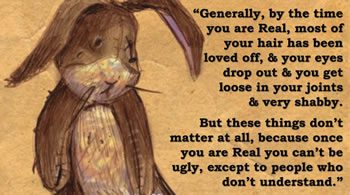Who Are You, Jesus?

Fr Tom Ryan
5. Learning from The Velveteen Rabbit
‘What is REAL?’ asked the Rabbit one day. ‘Real isn’t how you are made,’ said the Skin Horse. ‘It’s a thing that happens to you. When a child loves you for a long, long time, not just to play with, but REALLY loves you, then you become Real.’
Let’s think about this comment from Margery Williams’ The Velveteen Rabbit (see below). What does the book tell us about being Real, namely, about being one’s true self? How do I grow into the unique image of God that I am called to be?
 Levels of the Real
Levels of the Real
‘Real’ can mean many things. It can indicate what we do with our five senses; or efforts to understand ourselves (as in Psychology) and the experience of mystery (Religion); our desire to know and love (relationship); our yearning to find meaning about where we come from (origins), who we are (identity) and where we’re going (destiny).
The Velveteen Rabbit is less about what is ‘real’ or ‘not real’ and more about four different levels of reality.
The Rabbit is touched, seen, played with – the physical aspect. Second, unlike other cuddly dolls and toy ‘animals,’ this Rabbit has real behaviours: he breathes, cries and has emotions. Third, when he is REALLY loved, he is valued. He is more ‘real’ in becoming a self, in having an identity.
Finally, when he is discarded and forgotten, as the boy grows beyond toys, it still hurts. Yet, his sense of self is strong enough so that he does not disintegrate. When the Skin Horse (the wisdom figure) disappears, the Velveteen Rabbit has internalised his wisdom. In fact, his self-acceptance and humility dispose him to another form of life coming as a gift. He is transformed into a living, ‘flesh and blood’ rabbit.

“The glory of God is the human being fully alive”, St Irenaeus
Real as Alive
Real can also indicate life. It is always a gift, but can be a unique gift - a share in God’s life that, importantly, comes about through the medium of Jesus. He took on ‘flesh and blood’ (shares our humanity) so that we can be partakers in the divine nature. Paul says that we are “alive with a life that looks towards God” (Romans 6:11, Knox translation).
How often have we seen quoted the words from St Irenaeus? The glory of God is the human being fully alive.
Put like that, it seems to suggest we most resemble God when we stand alone as individuals. Then, I’m my fullest self.
But that’s not what Irenaeus meant. The next two Latin words have an implied question: ‘but what is life?’ His answer? In Latin, visio Dei.
Translation? - ‘the vision of God.’ But also ‘encountering God’; ‘face to face intimacy with God’; ‘living in God’s presence’; ‘up close and personal with God.’ Namely, what Paul says earlier about being “alive with a life that looks towards God.”
‘Fully alive’, then, only makes sense in a setting of a relationship. It is sharing in the divine life through Jesus - the Word, the one who is ‘from’ and ‘to’ the Father.
Far from being a project of individualism, it is a journey of love. We are part of creation’s pattern of relationships. With Moses, we are called to be ‘friends of God,’ sharing in a ‘face to face’ relationship. Or like the patriarch Enoch who ‘walked with God.’ To our final thought.
Real as Presence
To be ‘present’ involves various levels of ‘closeness’: at a public meeting, in a social gathering, at a family dinner, in a conversation with a friend, in the sacred space of sexual intimacy. The closer the ‘presence’ the greater the mutual awareness. Jesus, in his ‘real’ Eucharistic presence, gives himself as our food and as a friend.
Consider 1 John 3: 2. In God’s future, as children of God, we shall be like him because we shall see him as he really is.
Similarly, St Paul says that we with our unveiled faces reflect the brightness of the Lord, all grow brighter and brighter as we are turned into the image that we reflect, this is the work of the Lord who is Spirit
(2 Corinthians 3:18).
It is in the setting of mutual gaze, of transparency that is loving and unafraid, that we become more ‘alive’ in the image of Jesus. In his Canticle, St John of the Cross writes beautifully on how the Risen Jesus gazes into the story of each of us, not just benignly but effectively.
‘For God, to gaze is to love and to work favours.’ His love acts. It makes us ‘worthy and capable of his love.’
His gaze is his love and his love does things.
‘God’s gaze works four blessings in the soul: it cleanses her, makes her beautiful, enriches and enlightens her’ (Matthew, 140).
Loved into being one’s REAL self indeed!!
The Velveteen Rabbit is available online. It is really worth reading. The link is: digital.library.upenn.edu/women/williams/rabbit/rabbit.html
Reference: Iain Matthew, The Impact of God,
UK: Hodder and Stoughton, 1995
 Entries(RSS)
Entries(RSS)